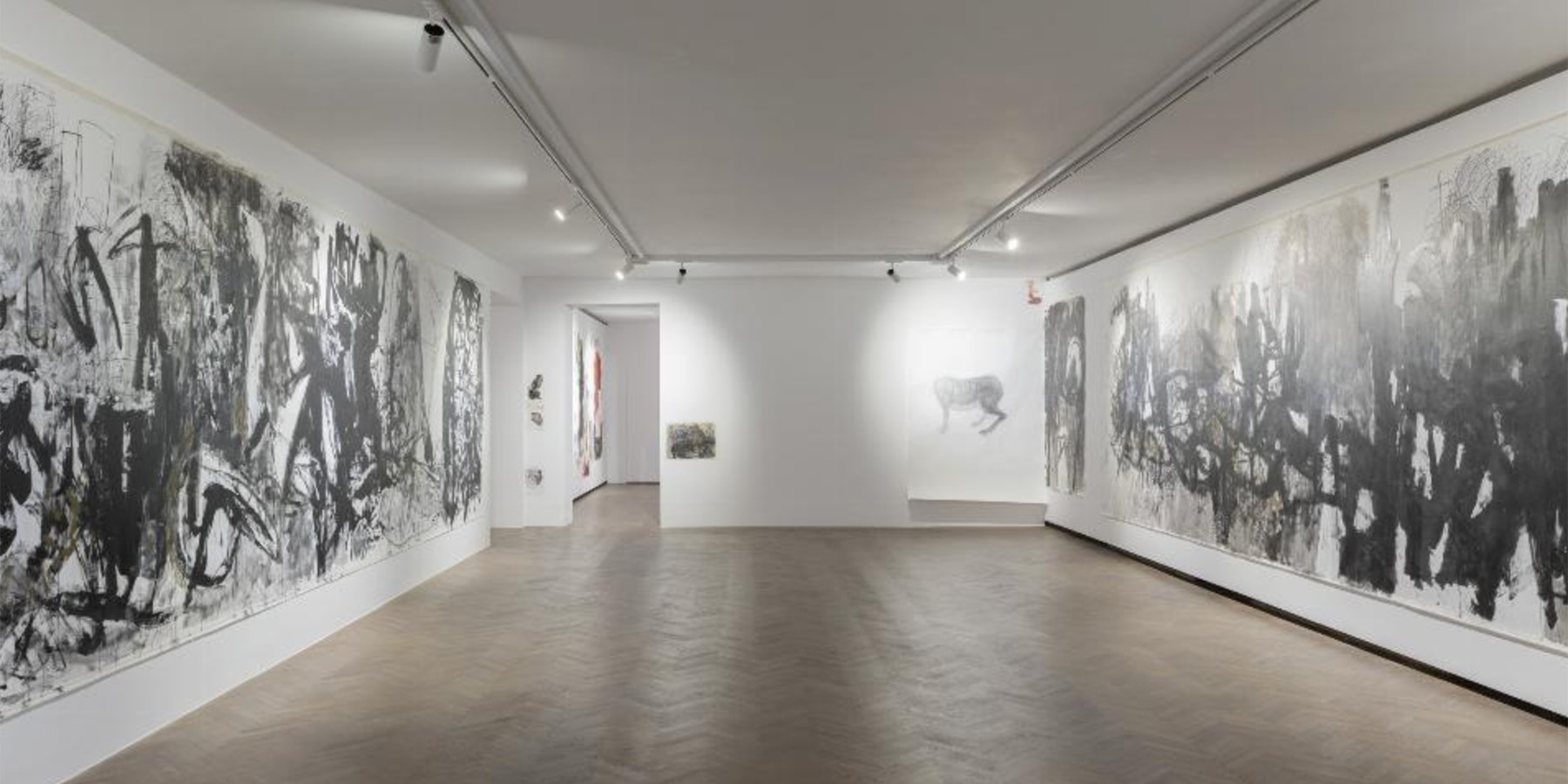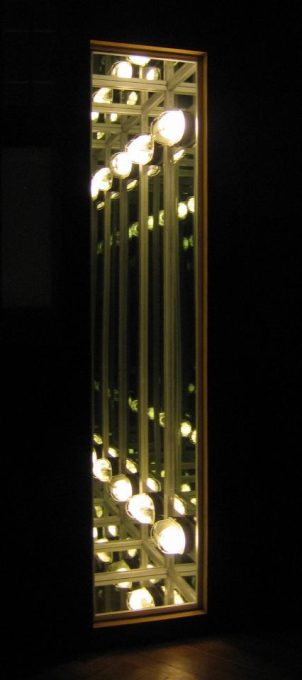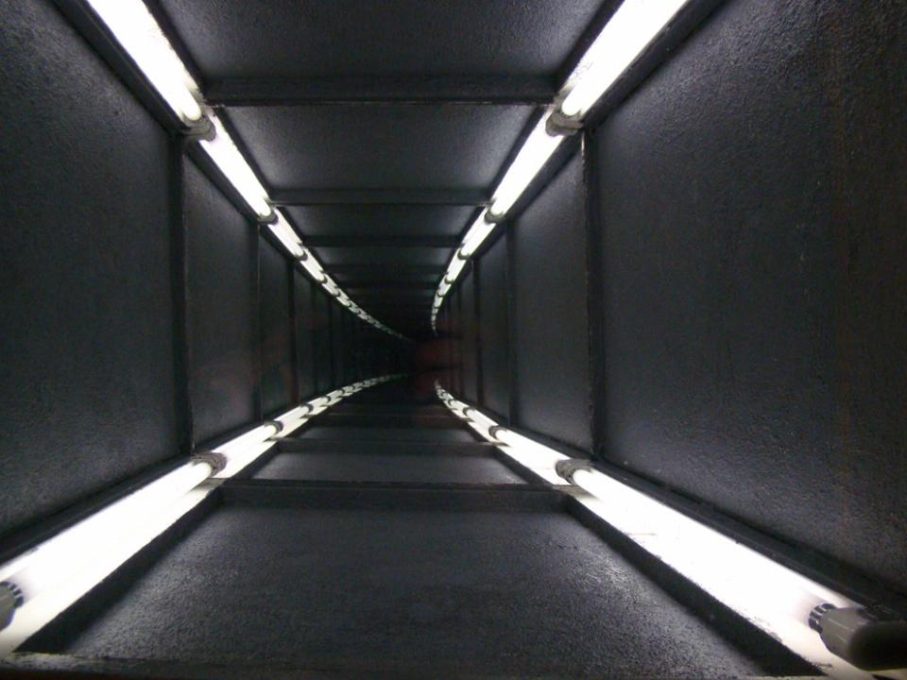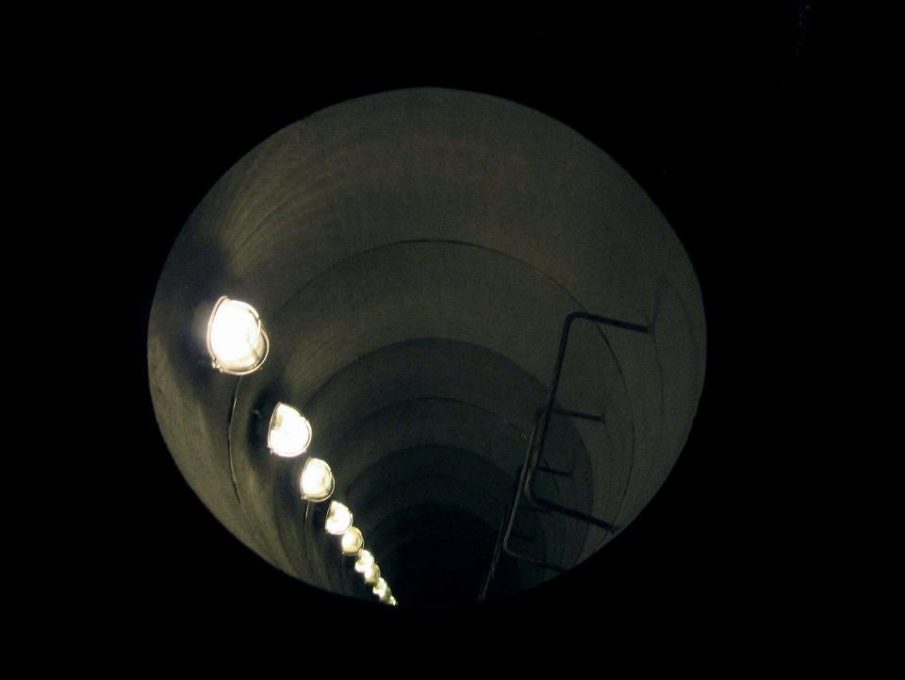LESZEK LEWANDOWSKI – Illusion of Space or the Discreet Charm of the Postmodernism
exhibition leaflet (pdf) – click to download
The Illusion of Space or a Discreet Charm of Postmodernism is my commentary on immediate reality and has all the features of the time I live in. It is like a fractal, a particle that reflects the whole and that contains the whole.
This is an object composed of a system of Venetian and traditional mirrors and a wooden MDF box (180 x 90 x 50 cm). Inside the box there is a construction of metal rods imitating a construction scaffolding. The resulting depth and multiplication of an image (because of the Venetian mirrors and a light system) creates an illusion of an infinite series of scaffoldings. On the one hand, we deal here with a reference to Postmodernism seen as constant construction through deconstruction; the ultimate point of decomposition that leads to the fractalisation of an image; a heterogenic system which is subject to constant internal differentiation and multiplications of borders. The work may also provoke one to follow Niklas Luhmann, who believes that art is an example of observation of the second degree and society regards itself in it and gets information on how rather than why it exists. Among others, the information concerns the fact that it exists poly-contexturally and that progressing differentiation calls for the skill to use a number of codes.This to my mind is the“discreet charm of Postmodernism”, and the entire contemporary art demonstrates best this heterogeneity. Postmodern art does not create finished works of art. It creates a new type of a recipient who takes the effort to come up with new interpretations, one playing with multiple senses and philosophical reflections on meaning, truth, and art (Jacques Derrida).
My object was created in Poland, which I see as a constant construction site with chaotic public space full of makeshift and temporary solutions. Surrounded with slapdash work, I feel like the protagonist of Terry Gilliam’sBrazil movie, where a small defect leads to a huge breakdown and ever-increasing problems. Being part of this reality, I create a “work” which is both intimately personal and significantly universal.
Artists that adopt a critical attitude to the world ask questions about objective truth and subjective foundations of reality, try to unmask uncritical and habitual ways of thinking and perceiving since not everything is as natural as it appears to us. My activity as an artist manifests my limited trust in reality as it is.
I make use of mathematical guidelines and knowledge from the area of optics. However, in objects with the use of mirrors (Well, Exit, Memento, The Coffin Portrait, Canal and the most recent one: ADiscreet Charm of Postmodernism) I also invoke what is irrational in the human being (Jacques Derrida’s notion of différance). The rationalists believed that we can get to know everything, while radical postmodernists maintain that omniscience is impossible. According to the latter, reality is not an independent entity perceived by the human mind but a construct created by it.
I treat science as one of the multiple ways of getting to know reality, but I avoid feeding my audiences with incomprehensible jargon. The tension between two types of intellectuals — those who create order within chaos and those who endeavour to undermine the established order — expands human ken. Although postmodernism(or postmodernity) is being trivialised, it remains a substantialelement that informs culture. Polish critics of postmodernism follow in large measure their political orientation which excludes approaches at variance with the “directives” of conservatism and Polish nationalism. According to them, postmodernism removes and abolishes ethics. As a man and artist I believe that we should “get rid of all preconceived notions in our thinking and find in ourselves a childlike openness” (Jean-Francois Lyotard) in order to be able to live in the world where all is as significant as it is unimportant.
Leszek Lewandowski
Translated by Marcin Turski
Leszek Lewandowski. Illusion of Space or a Discreet Charm of Postmodernism
The Illusion of Space or a Discreet Charm of Postmodernism exhibition gathers objects created by Leszek Lewandowski over the last dozen years or so. Many of them are a result of precise mathematical guidelines and knowledge in the field of optics. The artist then makes use of two areas of science that are generally perceived as the foundations of rationalism. Still, objects like Matzeva, Memento, The Coffin Portrait and Canal refer rather to what is illusory and irrational in human thinking, to the fissure that reveals – provided we are able to pinpoint it – genuine reality, a far cry from the banally conceived mathematical simplicity. However, how can we join the rational and the irrational in the face of mathematical precision? Is such a merger at all possible? The answer to the above question can be found in texts that seemingly belong to two divergent intellectual orders: The Mathematical Man written by a representative of Modernism and Cosmicomics by the leading European Postmodernist.
In his 1913 essay The Mathematical Man Robert Musil enumerates a whole series of properties of mathematics which make it the acme of all scholarly disciplines created by man. According to Musil, mathematics is an extremely economical way of thinking, an ideal thinking apparatus, whose added value lies in the ability to theoretically predict all possible incidents; thanks tomathematics an arduous task such as the summing up of an infinite sequence of numbers, can be solved under opportune circumstances within a matter of minutes.
Musil’s argument seems to be a rational praise of mathematics; what, then, can be the link with Cosmicomics by Italo Calvino, where the entire world and actually the whole universe seems to be turned upside down and all the laws, while respected in principle, are in fact intellectually absurd? In his stories Calvino is faithful to the principles of present-day science, which remains in the postmodern paradigm; we cannot find here meta-narratives and an ordering discourse which has the status of the sole instance of the truth. At the same time, however, despite his most astounding arguments Calvino preserves faith in the power of science as the conqueror of chaos. On the other hand, when Musil observes that one day it dawned on mathematicians thatthe foundations of the whole thing contain something that cannot in any possible way fit the rest, he sums up this discovery, rather scary from the rational point of view, as follows: we should therefore assume that all our existence is a dream and a nightmare; we owe it actually to an error without which it would never have come into being in the first place – does it not sound like an excerpt from the stories told by the old Qfwfq and Calvino’s other protagonists?
Like the mathematics in Musil, the art of Leszek Lewandowski is disinterested, uneconomical and passionate. The artist, similarly to Musil’s mathematician believes that what he is involved in will one day be practically useful, but this does not urge him to work […]He serves the truth, i.e. his fate, rather than the objective of this fate. Even if his efforts gave rise to a thousand economics, at bottom this is an unlimited dedication and passion. The practical advantage may in this case mean a change of perception habits, a challenge that is as alluring as it is chilling.
As the story about the development of the universe and the creation of life on Earth in Calvino offers the possibility of an alternative reading of facts established by teams of scientists, the art of Lewandowski reveals before the viewer new dimensions of perception and takes him or her on a trip equally fantastic as the descent into infinity of the narrator, Ursula H’x and Lieutenant Fenimore in the story The Form of Space. It helps demonstrate what seems impossible, what is existent as a result of our perception and non-existent at the same time, as a mere optical illusion. The artist applies visual means to continue the efforts of both writers and creates a reality which is an alternative to the viewer’s immediate reality and which becomes equally legitimate. This is precisely where the power of art lies: it is capable of creating and testing parallel worlds, of taking into consideration an infinite number of options, of regarding an infinite series of incidents. Such art, thanks to an adequate visual language, becomes a tool of cognition as precise as mathematics or physics, which at the same time preserves the disinterestedness characteristic especially of the former discipline.
Leszek Lewandowski, like Italo Calvino, starting off with rational, mathematical and physical principles, leads us into the world of fantasy, illusion and bewilderment, which however never completely departs from the element of the scientific.
Marta Raczek
translated by Marcin Turski
Curator: Monika SzewczykLeszek Lewandowski

PLAN YOUR VISIT
Opening times:
Thuesday – Sunday
10:00-18:00
Last admission
to exhibition is at:
17.30


